Video art is an art form which relies on using video technology as a visual and audio medium. Video art emerged during the late 1960s as new consumer video technology such as video tape recorders became available outside corporate broadcasting. Video art can take many forms: recordings that are broadcast; installations viewed in galleries or museums; works streamed online, distributed as video tapes, or DVDs; and performances which may incorporate one or more television sets, video monitors, and projections, displaying live or recorded images and sounds.

Bruce Nauman is an American artist. His practice spans a broad range of media including sculpture, photography, neon, video, drawing, printmaking, and performance. Nauman lives near Galisteo, New Mexico.
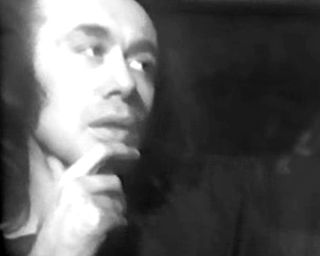
Vito Acconci was an American performance, video and installation artist, whose diverse practice eventually included sculpture, architectural design, and landscape design. His performance and video art was characterized by "existential unease," exhibitionism, discomfort, transgression and provocation, as well as wit and audacity, and often involved crossing boundaries such as public–private, consensual–nonconsensual, and real world–art world. His work is considered to have influenced artists including Laurie Anderson, Karen Finley, Bruce Nauman, and Tracey Emin, among others.
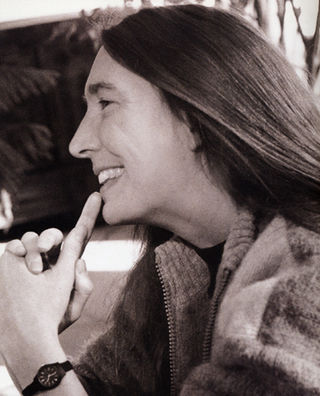
Jenny Holzer is an American neo-conceptual artist, based in Hoosick, New York. The main focus of her work is the delivery of words and ideas in public spaces and includes large-scale installations, advertising billboards, projections on buildings and other structures, and illuminated electronic displays.
Martha Rosler is an American artist. She is a conceptual artist who works in photography and photo text, video, installation, sculpture, and performance, as well as writing about art and culture. Rosler's work is centered on everyday life and the public sphere, often with an eye to women's experience. Recurrent concerns are the media and war, as well as architecture and the built environment, from housing and homelessness to places of passage and systems of transport.

The Museum of Contemporary Art San Diego, in San Diego, California, US, is an art museum focused on the collection, preservation, exhibition, and interpretation of works of art from 1950 to the present.
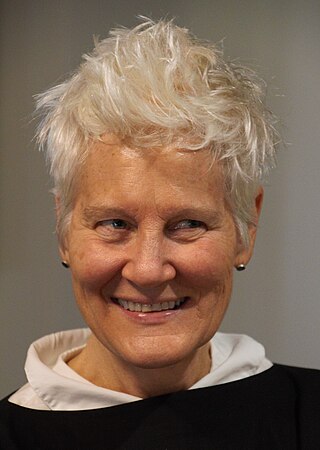
Ann Hamilton is an American visual artist who emerged in the early 1980s known for her large-scale multimedia installations. After receiving her BFA in textile design from the University of Kansas in 1979, she lived in Banff, Alberta, and Montreal, Quebec, Canada before deciding to pursue an MFA in sculpture at Yale in 1983. From 1985 to 1991, she taught on the faculty of the University of California at Santa Barbara. Since 2001, Hamilton has served on the faculty of the Department of Art at the Ohio State University. She was appointed a Distinguished University Professor in 2011.
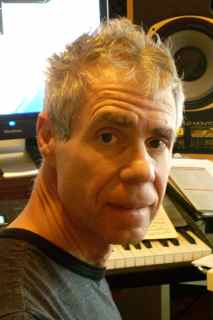
Joseph Martin Waters(born 1952) is an American classical composer. He also mounts experimental electronic music festivals attempting to bridge the gap between contemporary popular genres and the avant-garde Western classical tradition.
Sandra Binion is a Swedish-American artist based in Chicago whose artistic practice includes fine-art exhibitions, multimedia installations involving, and performance art. Her work has been performed and exhibited at museums, galleries, theaters, and festivals in the US, Europe, and Japan. Some of the venues that have featured her work include the Evanston Art Center, Link's Hall, Kunstraum (Stuttgart), The Goodman Theatre, and Los Angeles Institute of Contemporary Art.

Mark Tribe is an American artist. He is the founder of Rhizome, a not-for-profit arts organization based in New York City.
Elena Lomakin is a contemporary Russian-American artist. Her main body of work and paintings is influenced by nature and is considered abstract expressionism.

James Luna was a Puyukitchum, Ipai, and Mexican-American performance artist, photographer and multimedia installation artist. His work is best known for challenging the ways in which conventional museum exhibitions depict Native Americans. With recurring themes of multiculturalism, alcoholism, and colonialism, his work was often comedic and theatrical in nature. In 2017 he was awarded a Guggenheim Fellowship.

Nick Cave is an American sculptor, dancer, performance artist, and professor. He is best known for his Soundsuit series: wearable assemblage fabric sculptures that are bright, whimsical, and other-worldly, often made with found objects. He also trained as a dancer with Alvin Ailey and often incorporates dance and performance into his works. His later sculptures have focused on color theory and included mixed media and large-scale installations. He lives in Chicago, Illinois, and directs the graduate fashion program at the School of the Art Institute of Chicago. He continues to work on Soundsuits as well as works completed as a sculptor, dancer, and performance artist.
Jean Lowe is a California-based painter and sculptor. She creates installations and sculptural works of enamel-painted papier-mâché.
Victoria Fu is an American visual artist who is working in the field of digital video and analog film, and the interplay of photographic, screen based, and projected images.
Rebeca Bollinger is an American artist. She works with sculpture, photography, video, drawing, installation, writing and sound.
The Vessel Orchestra is a sound-based art installation created by British artist Oliver Beer. It is the first sound-oriented installation ever commissioned by the Metropolitan Museum of Art. The installation is composed of 32 objects from the museum's collection. Each object has a microphone placed in its hollow space in order to capture the natural sounds that each piece resonates. Beer chose each object for its unique pitch. For instance, a clay vase by Joan Miró resonates the musical note low F. The internal microphones, which do not touch the objects, are connected to a mixer, which is hooked up to a keyboard, therefore allowing a musician to "play" the objects, creating music. The installation was opened to the general public on July 2, 2019, and was on display at the Met Breuer until August 11, 2019. During the exhibit the installation played repeatedly a 20-minute loop of a composition by Beer. In addition, the instrument was played on Friday evenings during live music performances by guest musicians. The installation includes two and a half octaves in a chromatic scale, from low C to high G. It took Beer four years to create the installation. Some of the objects in the installation had never been on display in the museum before. The project was co-curated by Lauren Rosati and Limor Tomer.
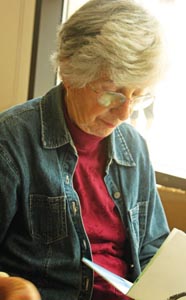
Genie Shenk (1937–2018) was a San Diego, California-based American artist, editor, and educator who also worked in fiber arts, creating quilts of handmade paper she pressed from natural and recycled materials. Her work focuses on book art and has strong references to Jungian philosophy, where she recorded her dreams in visual form.
Roxanne Nesbitt is a Canadian interdisciplinary artist who works in intersections between sound and design. Born in Edmonton, Alberta, of Indo-Caribbean and European mixed ancestry, she holds a Bachelor of Music from University of Alberta and a Masters of Architecture from UBC. Her work involves creating handmade instruments, composition, improvisation, sound installation, and performance. Her compositions have premiered internationally, including at Gadeamus Muziekweek in Utrecht, and at Bauchhund in Berlin; additionally, she received an honorable mention in Musicworks' 2020 Electronic Music Competition. She makes her home on Coast Salish territory in Vancouver, where, in addition to her practice, she is co-director of Currently Arts Society, a community organization prioritizing under-represented artists.



















